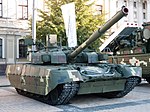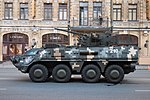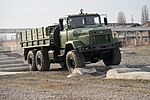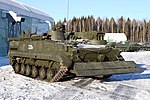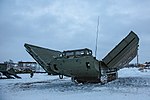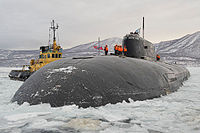User:Holynia/Sandbox: Difference between revisions
| Line 337: | Line 337: | ||
== Ranks and insignia == | == Ranks and insignia == | ||
=== Officers === | === Officers === | ||
=== | {| style="border:1px solid #8888aa; background-color:#f7f8ff; padding:5px; font-size:95%; margin: 0px 12px 12px 0px;" | ||
|- style="background-color:#CCCCCC; width: 100%" | |||
! NATO code !! colspan=2 | OF-10 !! colspan=2 | OF-9 !! colspan=2 | OF-8 !! colspan=2 | OF-7 !! colspan=2 | OF-6 !! colspan=2 | OF-5 !! colspan=2 | OF-4 !! colspan=2 | OF-3 !! colspan=2 | OF-2 !! colspan=6 | OF-1 !! colspan=6 | {{wp|Officer candidate|OF(D)}} !! colspan=6 | Student officer | |||
<includeonly>|-</includeonly><noinclude> | |||
|- style="text-align:center;" | |||
|rowspan=2| {{flagicon|Holynia}} '''[[Holynia|Holyn Kingdom]]<br>''Epaulette rank insignia''''' | |||
| colspan=2| [[File:Russia-Army-OF-10-1994-parade.svg|50px|Marshal]] | |||
| colspan=2| [[File:Russia-Army-OF-9-1994-parade.svg|50px|Army General]] | |||
| colspan=2| [[File:Russia-Army-OF-8-1994-parade.svg|50px|Colonel General]] | |||
| colspan=2| [[File:Russia-Army-OF-7-1994-parade.svg|50px|Lieutenant General]] | |||
| colspan=2| [[File:Russia-Army-OF-6-1994-parade.svg|50px|Major General]] | |||
| colspan=2| [[File:Russia-Army-OF-5-1994-parade.svg|50px|Colonel]] | |||
| colspan=2| [[File:Russia-Army-OF-4-1994-parade.svg|50px|Lieutenant-Colonel]] | |||
| colspan=2| [[File:Russia-Army-OF-3-1994-parade.svg|50px|Major]] | |||
| colspan=2| [[File:Russia-Army-OF-2-1994-parade.svg|50px|Captain]] | |||
| colspan=3| [[File:Russia-Army-OF-1b-1994-parade.svg|50px|Lieutenant]] | |||
| colspan=3| [[File:Russia-Army-OF-1a-1994-parade.svg|50px|Second Lieutenant]] | |||
| colspan=6 |[[File:Russia-Army-OF-(D)-2010.svg|50px|Officer Cadet]] | |||
| colspan=6 rowspan=2| '''''No equivalent''''' | |||
|- style="text-align:center;" | |||
| colspan=2| {{wp|Field Marshal|Marshal}} | |||
| colspan=2| {{wp|Army General|Army<br>General}} | |||
| colspan=2| {{wp|Colonel General|Colonel<br>General}} | |||
| colspan=2| {{wp|Lieutenant General|Lieutenant<br>General}} | |||
| colspan=2| {{wp|Major General|Major<br>General}} | |||
| colspan=2| {{wp|Colonel}} | |||
| colspan=2| {{wp|Lieutenant Colonel|Lieutenant<br>Colonel}} | |||
| colspan=2| {{wp|Major}} | |||
| colspan=2| {{wp|Captain (rank)|Captain}} | |||
| colspan=3| {{wp|First Lieutenant|First<br>Lieutenant}} | |||
| colspan=3| {{wp|Second Lieutenant|Second<br>Lieutenant}} | |||
| colspan=6| {{wp|Officer Cadet|Officer<br>Cadet}} | |||
== Commanders == | == Commanders == | ||
=== Commander-in-chief (2001–present) === | === Commander-in-chief (2001–present) === | ||
Revision as of 16:22, 7 November 2021
| Royal Holyn Defence Forces | |
|---|---|
| Kráľovské Holynské Obranné Sily | |
 Emblem of the Royal Holyn Defence Forces | |
 Banner of the Royal Holyn Defence Forces | |
| Founded | 1743 (Army of the Holyn Kingdom) 12 November 1925 (Holyn People's Army) 12 November 1950 (Holyn Armed Forces) |
| Current form | 7 April 2002 |
| Service branches | |
| Leadership | |
| Monarch | |
| Defence Minister | |
| Chief of Staff | x x |
| Chief of General Staff | |
| Personnel | |
| Military age | 16-17 with parental consent, 18 without parental consent and serve in combat roles |
| Conscription | Inactive, registration continues but not enforced |
| Active personnel | 491,340 (ranked 7th) |
| Reserve personnel | 753,127 |
| Expenditure | |
| Budget | $101.3 billion |
| Percent of GDP | 4.5 |
| Industry | |
| Domestic suppliers | List |
| Holyn Kingdom Defence Forces |
|---|
 |
| Staff |
| Services |
| Independent troops |
| Geographic Commands |
|
| Specialist Commands |
|
| History of the Holyn military |
The Royal Holyn Defence Forces is the military force of Holynia comprising the Holyn Ground Force, Royal Holyn Air Force, Royal Holyn Navy, Royal Holyn Strategic Forces, along with two independent arms of service; the Royal Holyn Marines and the Holyn Airborne Assault Forces.
Holynia has maintained a standing military since 1743, however the current interation traces its roots to the Holyn People's Army founded in 1925. This force was reformed in 1950 into the Holyn Armed Forces. The collapse of communist Holynia and separatist rebellion in Bogoria saw the Holyn Armed Forces begin to splinter and disintegrate. Elements of the military were accussed of war crimes, including ethnic cleansing. The military was reorganized in 2001 as the Holyn Defence Forces, adding the Royal prefix in 2002. The military underwent rebuilding and modernization in the 2000s and 2010s.
The head of the military is the Holyn monarch, currently King Mikulas I, the figure that service members swear allegiance to. The constitution, however, vests de facto executive control of the military in the Prime Minister, Minister of Defence who lead the National Security Council. The Chiefs of the General Staff leads the day to day operations of the military.
The Royal Holyn Defence Forces is authorized for 493,700 personnel under the FY2021 budget. The military is entirely volunteer based, with conscription ending in 2005. Civilians must still register for conscription once they reach 18 years of age, however, are not called for service. The military budget of Holynia is around $101.3 billion. Three branches of the military operate nuclear weapons, the Royal Holyn Air Force, Royal Holyn Navy and the Holyn Strategic Forces. Two independent uniformed security forces are seperate of the Royal Holyn Defence Forces and fall under the two Principalities of Holynia, Hornatyia and Masovia. These are the Hornatyian National Guard and Masovian National Guard.
History
Service Branches
The Royal Holyn Defence Forces are made up of four main service branches and two independent troop branches.
Main service branches
The land warfare branch of the Defence Forces. Consists of 190,000 active duty personnel, supported by 370,500 reserve personnel. Largest branch of the military by size.
The naval warfare branch of the Defence Forces. Consists of 133,500 active duty personne, supported by 31,000 reserve personnel.
The aerial warfare branch of the Defence Forces. Consists of 121,300 active duty personnel, supported by 51,000 reserve personnel.
Strategic missile force of the Defence Forces. Consists of 12,500 active duty personnel and 3,500 reserve personnel.
Independent troops branches
Maritime and expeditionary force of the Defence Forces. Consists of 21,000 active duty personnel and 9,100 reserve personnel.
Airborne assault force of the Defence Forces. Consists of 12,000 active duty personnel and 3,500 reserve personnel.
Holyn Ground Forces
| Holyn Ground Forces | |
|---|---|
| Holynské Pozemné Sily | |
Emblem of the Holyn Ground Forces | |
| Active | 1923–present |
| Country | |
| Type | Army |
| Size | 190,000 active duty 370,500 reserve |
| Part of | Royal Holyn Defence Forces |
| Headquarters | Cizekporok |
| Colors | Red Black Grey Green |
| Anniversaries | 3 March |
| Engagements | Bogorian War for Independence Holyn-Bogorian Border Conflict (2002-present) |
| Commanders | |
| Commander of the Holyn Ground Forces | |
| Deputy Commander of the Holyn Ground Forces | |
| Insignia | |
| Flag | |
The Holyn Ground Forces (Holyn: Holynské Pozemné Sily) is the land forces of the Royal Holyn Defence Forces. As of 2020, the Holyn Ground Forces has 190,000 active duty and 370,500 reserve personnel, totalling 580,500 personnel. It maintains forces across Holynia in both active duty and part time reserve roles.
History
The Holyn Ground Forces in its current form was formed on 20 May 2001, in the aftermath of the war in Bogoria. The Ground Forces inherited the personnel, command structure and equipment of the former communist Holyn Army. The military was in a rapid state of collapse with desertions, low morale, destroyed equipment, and limited funding. The military however was consumed with the ongoing war in Bogoria. A peace treaty was finally signed in 2002, with the Holyn military withdrawing from Bogoria throughout the summer. A massive demobilization had to be undertaken, writing off entire divisions deemed unneccesary in post-communist Holynia. The Ground Forces went from 20 divisions in 2002 to 9 by 2003.
Post-war reforms
Holynia's military was viewed as "inefficient" by the new government. Minister of Defence Cvesek stated a top to bottom reform had to occur. A post-war parliamentary commission also recommended the Ground Forces be rebuilt. The commission found a bloated officer corps and lack of NCOs led to poor control of the ground forces when dealing with the quasi insurgency in Bogoria. Contradictory orders led to failed operations and high casualties. Poor training, especially of infantry contributed to the high casaulty rate. Lack of coordination and communication with the Air Force meant air support, the biggest advantage the Holyn military had, was insufficient.
A seperate parliamentary inquiry accussed the ground forces of participating in an "organized ethnic cleansing campaign" organized by "senior officers". Roughly 7,000 enlisted and commissioned personnel were dishonorably discharged related to these events. A highly publicised incident occurred where investigators working for the parliamentary inquest were held at gun point by army officers refusing to turn over records. Public opinion gradually turned against the military as details of wartime attrocities were publicised.
In March 2003, the first reform plan was unveiled before the Narodna Rada. The Ground Forces would be reduced to a total personnel count of 400,000 active duty. Among other reforms proposed were ending conscription and reducing the number of commissioned officers.
2003 Reform Proposal
- Reduce Ground Forces from 750,000 active personnel to 400,000.
- Create a professional NCO corps.
- Reduce officer count.
- End conscription by 2005.
- Increase size of reserves.
- Increase personnel pay.
The reforms began to implemented in the fall of 2003, with a series of buyouts of commissioned officers and merging several military academys. In January 2004, the new reserve structure was unveiled, with a officer corps and enlisted corps. The Defense Ministry set a goal of having 2 reserve divisions fully staffed with officers and enlisted personnel by 2005. In May 2004, the first NCO academy was established in Cizekporok at the former campus of the defunct Military-Political Academy.
Significant reorganization of the structure of the Ground Forces continued throughout 2005. The Military Districts were dissolved, with the command structure changing from (Military District - Army - Division - Regiment) to (Unified Military Command - Division - Regiment). The Unified Military Commands would be unified commands for all branches of the Defence Forces, with the goal of creating better coordination between branches.
In February 2005, the final draft was held with 13,000 men conscripted into the Ground Forces for 12 month mandatory service. The new contract/volunteer program for enlisted personnel began with the 785th Recruitment Brigade established. Four more recruitment brigades would be founded in 2005 to assist with attracting and retaining contract personnel. The Ministry of Defence stated 40% of conscripts in 2005 opted to remain in the military, signing 4 year contracts. Higher pay was attributed to the rise in contract personnel, with pay rising from U$300/month for a conscript to U$1,900/month for a contract soldier.
2009 rearmament plan
2018 reform plan
Structure
The Ground Forces are commanded by the Ground Forces Commander, a General of the Army, from the Ground Forces Headquartes in the Defence Ministry building in Cizekporok. Three operation commands, Ground Force Operations Command, Ground Force Training and Support Command, and Special Operations Command are subordinate to the Ground Forces Command. The Capital Defence Command reports directly to the Ground Forces Headquarters and is independent of the other Ground Forces Command. Five geographic commands, roughly equivalent of a corps are subordinated to the Ground Force Operations Command. The five geographic commands consist of 2-3 motor rifle (combined arms) or tank (armoured) divisions.
Personnel branches
Personnel in the Holyn Ground Forces belong to a Personnel Branch applicable to their trade/unit. These include the Motorised Rifle (Infantry), Tank (Armoured), Artillery, Rocket Artillery, Air Defence Corps, Aviation Corps, among others. Several sub-branches gain additional distinction. These include (in order of precedence): Life-Guards, Royal Guards and standard Guards units.
Life Guards troops are the personal division of the Holyn monarch. The Life Guards are the formal personal protection detail of the monarch. Formally they report directly to the King, but de-facto follow the standard chain of command of the Ground Forces. They are considered the most elite branch of the Ground Forces and wear special uniforms as the personal protection detail of the monarch. They perform ceremonial guard duties throughout the capital.
Hussars troops are the calvary branch of the Ground Forces. They are the quick reaction forces of the Ground Forces and tend to be equipped with Main Battle Tanks and light vehicles, combining both speed and armour in their ranks. They wear seperate uniforms from standard Motor Rifle troops. They are considered elite units, above a standard Guards unit.
Motor Rifle troops are the infantry branch of the Ground Forces. They are equipped with a variety of weapons for different tasks including armored troop carriers, tanks, artillery, anti-aircraft weapons and mortars. The Ground Forces have 7 Motor Rifle divisions.
Tank troops are the armored branch of the ground forces. Tank divisions are made up primarily by Tank regiments. Main battle tanks are the primary equipment of the tank troops, however other heavy weaponry including fire support vehicles support main battle tanks. Tank troops are geared as shock forces, meant to break through enemy lines and lead offensive operations. The Ground Forces has 5 Tank divisions.
Artillery and Rocket Artillery troops make up artillery regiments. They are geared to support motor rifle troops and tank troops by providing fire support.
Intelligence, Signals, Reconnaisance and Communications troops are one of the support branches of the Ground Forces. The Aviation Corps consists of enlisted and officers responsible for flying and maintaining the aircraft of the Ground Forces. The Air Defence Corps is responsible for the air defence of the Ground Forces as well as maintaining a wide array of fixed radars across Holynia. The Royal Medical Corps is responsible for healthcare services of the Ground Forces and frequently assists the other branches of the Defence Forces. The Logistics Corps assists with supplies and maintanance of the ground forces.
Personnel
The personnel of the Ground Forces consist of 201,600 active duty and 370,500 reserve personnel. Regular Service personnel are active duty enlisted personnel. They are full-time professional soldiers who sign a four year initial contract and additional contracts between four to nine years. Primary Reserves consist mainly of combat and support units. The other aspect of reserve personnel are the Secondary Reserve, which primarily consist of support units. Both Reserves are paid and receive benefits, but at a lower scale compared to Regular Service personnel.
Conscription was the primary form of recruitment prior to 2005. All personnel since 2005, full-time and reserve, have been volunteers. Enlisted personnel that were originally conscripted prior to 2005 still remain in the ground forces. They make up 9% of active duty personnel and have voluntarily signed contracts since being enlisted.
Regular Service
The Regular Service personnel are 190,600 active duty full-time enlisted and commissioned personnel. They are subject to deployment and have long term contracts. Training is subsidised for enlisted personnel, while officer cadets pay tuition which is then waived once they receive their commission. Regular Service personnel receive pay based on rank and length of service. They make up 52 regiments, 21 seperate battalions and 11 seperate companies. Many regiments are only enlisted from specific demographics or regions. Regular Service personnel make up the entirety of the household division (9th Guards Tank Household Division Cizekporok - Prince Vinazlec). All other divisions divide regiments into Regular Service and Primary/Secondary Reserve.
All enlisted and officer cadet recruits receive 5 weeks of initial training, either Initial Soldier Training or Initial Cadet Training. Enlisted personnel then move onto specialised training of 9-12 weeks for their respective trade. Officer cadets will move onto their respective academy.
Many Regular Service personnel sign contracts which commit them to 2-5 years of Primary/Secondary Reserve service. All other enlisted Regular Service personnel who elect to leave either are discharged or become Immediate Reserve, which is seperate from the Primary/Seconday Reserve. Immediate Reserve is a holdover from the Communist era. Immediate Reserve receive no pay and no obligation for training. In an emergency, Parliament may call up Immediate Reserve for active duty. In the Communist era, this duty was mandatory for all military personnel leaving on good terms, however since 2002 has been voluntary.
Primary Reserve
The Primary Service consists of 210,500 personnel. They are part-time and full-time volunteer soldiers, NCOs and reserve officers. Primary Reserve are both civilian volunteers and Regular Service personnel who volunteered for Primary Reserve. Primary Reserve undergo similar initial training to Regular Service personnel and receive ongoing training which they must attend at least 2 days per month. Some Primary Reserve units are at constant readiness, meaning some members, generally officers, work full time. Primary Reserve personnel are assigned to units, similar to Regular Service units, but are only part time manned units. The Primary Reserve staffs all front line reserve units along with support units. Most Divisions feature a 40/60 mix of Regular Service and Reserve personnel. Primary Reserve may be called up for service by the Minister of Defence for up to 365 days.
Secondary Reserve
Secondary Reserve consists of 160,000 part time personnel. Secondary Reserve undergos similar training to the Primary Reserve. Secondary Reserve staff most support divisions and several administrative units. They do not serve in front-line units, receive less pay than Regular Service or Primary Reserve personnel. They must attend drills 2 days per month and may be activated for up to 365 days by the Minister of Defence. Secondary Reserve heavily recruits medical, clerical and other skilled trades to man specific units.
Organization
The Holyn Ground Forces are made up into 7 Motor Rifle Divisions (Combined arms) and 5 Tank Divisions (Armored). Motor Rifle Divisions typically have 1-2 tank regiments, 3-4 motor rifle regiments, 1-2 artillery regiments, an air defence regiment and 8 additional battalions consisting of anti-tank, engineering, intelligence, reconassiance, signals, NBC-defence, transport, supply/logistics, maintenance, and medical units. In addition 1-2 aviation company(s). Tank divisions reverse the order of Tank and Motor Rifle regiments. A division will consist of active duty units and reserve units.
| Type of unit | Field Army (Wartime) | Commands (Peacetime) | Division | Battlegroup | Regiment | Company, Squadron, Battery | Platoon or Troop | Section | Fire team |
|---|---|---|---|---|---|---|---|---|---|
| Contains | 3 divisions | 2 divisions | 6-9 regiments, 9-10 support battalions, 2-3 support companies | 3–5 regiments | 4–6 companies | 3 platoons | 3 sections | 2 fire teams | 4 individuals |
| Personnel | 37,000 | 25,000 | 12,000 | 5,000 | 700–1,000 | 120 | 30 | 8–10 | 4 |
| Commanded by | Armádní generál | Armádní generál | Generálporučík | Podplukovník | Podplukovník | Major | Nadporučík or Poručík | Rotný | Četař |
Equipment
Equipment summary
| Type | Active | Reserve |
|---|---|---|
| Main battle tanks | 1,627 | 2,338 |
| Infantry fighting vehicles | 2,457 | ≈2,600 |
| Armoured personnel carriers | 2,435 | ≈1,800 |
| Towed artillery | 3,071 | ≈8,000 |
| Self-propelled artillery | 3,071 | ≈1,800 |
| Rocket artillery | 1,352 | 900 |
| AA systems | 1,137 | ≈900 |
Uniforms
The uniforms of the Ground Forces vary between service branches and units. The standard officer daily service uniform is a pine green jacket with green epaulettes. A peaked cap is worn with a gold cockade of the Ground Forces emblem. The daily service uniform features green plastic/fabric buttons. The formal service uniform adds gold/red piping to the uniform, a red band on the cap and gold buttons to the coat. Gold epaulettes replace the green epaulettes. The enlisted service uniform is the same, with red epaulettes replacing the gold on the formal service uniform. The winter model adds a green great coat for both junior officers and enlisted. A parka is also offered. This may be worn with or without the jacket depending on needs of the soldier. A brown belt may also be worn depending on the occasion.
The standard parade uniform is split into the inspection model and the stand by model. The inspection model is for soldiers walking out on parade. Officer models feature a gold ceremonial belt with commission sword signifying their status as an officer. Enlisted and non-commissioned officers (NCOs) wear a white belt. Jack boots are worn with the walk out model of the parade uniform. The great coat for senior officers is grey instead of the standard gold.
The work uniform consists of either a camoflauge or pine green shirt with epaulettes. Berets replace the peaked caps. Boots are typically worn, either sage green or black (depends on the unit).
The combat uniform consists of a HolCam 2 camoflauge pattern coat, with accompying gear. Sage green boots are the only authorized combat boots.
Specific units wear different parade uniforms than standard servicemembers. The officer and enlisted uniform of the Royal Hussars is a red tunic with a closed collar. Hussars wear a shako instead of a peaked cap. The Royal Life Guards wear a red tunic with closed collar, but retain the standard peaked cap. The Royal Dragoons wear a light black/grey closed collar tunic with a shako. All these specific units wear a grey great coat in the winter. They retain the standard service uniforms of the Ground Forces for all other uses.
Ranks and insignia
Officers
| NATO code | OF-10 | OF-9 | OF-8 | OF-7 | OF-6 | OF-5 | OF-4 | OF-3 | OF-2 | OF-1 | OF(D) | Student officer | |||||||||||||||||||||||||||||||||||||||||||||||||||||||||||||||||||||||||||||||||||||||||||||||||||||||||||||||||||||||||||||||||||||||||||||||||||||||||||||||||||||||||||||||||||||||||||||||||||||||||||||||||||||||||||||||||||||||||||||||||||||||||||||||||||||||||||||||||||||||||||||||||||||||||||||||||||||||||||||||||||||||||||||||||||||||||||||||||||||||||||||||||||||||||||||||||||||||||||||||||||||||||||||||||||||||||||||||||||||||||||||||||||||||||||||||||||||||||||||||||||||||||||||||||||||||||||||||||||||||||||||||||||||||||||||||||||||||||||||||||||||||||||||||||||||||||||||||||||||||||||||||||||||||||||||||||||||||||||||||||||||||||||||||||||||||||||||||||||||||||||||||||||||||||||||||||||||||||||||||||||||||||||||||||||||||||||||||||||||||||||||||||||||||||||||||||||||||||||||||||||||||||||||||||||||||||||||||||||||||||||||||||||||||||||||||||||||||||||||||||||||||||||||||||||||||||||||||||||||||||||||||||||||||||||||||||||||||||||||||||||||||||||||||||||||||||||
|---|---|---|---|---|---|---|---|---|---|---|---|---|---|---|---|---|---|---|---|---|---|---|---|---|---|---|---|---|---|---|---|---|---|---|---|---|---|---|---|---|---|---|---|---|---|---|---|---|---|---|---|---|---|---|---|---|---|---|---|---|---|---|---|---|---|---|---|---|---|---|---|---|---|---|---|---|---|---|---|---|---|---|---|---|---|---|---|---|---|---|---|---|---|---|---|---|---|---|---|---|---|---|---|---|---|---|---|---|---|---|---|---|---|---|---|---|---|---|---|---|---|---|---|---|---|---|---|---|---|---|---|---|---|---|---|---|---|---|---|---|---|---|---|---|---|---|---|---|---|---|---|---|---|---|---|---|---|---|---|---|---|---|---|---|---|---|---|---|---|---|---|---|---|---|---|---|---|---|---|---|---|---|---|---|---|---|---|---|---|---|---|---|---|---|---|---|---|---|---|---|---|---|---|---|---|---|---|---|---|---|---|---|---|---|---|---|---|---|---|---|---|---|---|---|---|---|---|---|---|---|---|---|---|---|---|---|---|---|---|---|---|---|---|---|---|---|---|---|---|---|---|---|---|---|---|---|---|---|---|---|---|---|---|---|---|---|---|---|---|---|---|---|---|---|---|---|---|---|---|---|---|---|---|---|---|---|---|---|---|---|---|---|---|---|---|---|---|---|---|---|---|---|---|---|---|---|---|---|---|---|---|---|---|---|---|---|---|---|---|---|---|---|---|---|---|---|---|---|---|---|---|---|---|---|---|---|---|---|---|---|---|---|---|---|---|---|---|---|---|---|---|---|---|---|---|---|---|---|---|---|---|---|---|---|---|---|---|---|---|---|---|---|---|---|---|---|---|---|---|---|---|---|---|---|---|---|---|---|---|---|---|---|---|---|---|---|---|---|---|---|---|---|---|---|---|---|---|---|---|---|---|---|---|---|---|---|---|---|---|---|---|---|---|---|---|---|---|---|---|---|---|---|---|---|---|---|---|---|---|---|---|---|---|---|---|---|---|---|---|---|---|---|---|---|---|---|---|---|---|---|---|---|---|---|---|---|---|---|---|---|---|---|---|---|---|---|---|---|---|---|---|---|---|---|---|---|---|---|---|---|---|---|---|---|---|---|---|---|---|---|---|---|---|---|---|---|---|---|---|---|---|---|---|---|---|---|---|---|---|---|---|---|---|---|---|---|---|---|---|---|---|---|---|---|---|---|---|---|---|---|---|---|---|---|---|---|---|---|---|---|---|---|---|---|---|---|---|---|---|---|---|---|---|---|---|---|---|---|---|---|---|---|---|---|---|---|---|---|---|---|---|---|---|---|---|---|---|---|---|---|---|---|---|---|---|---|---|---|---|---|---|---|---|---|---|---|---|---|---|---|---|---|---|---|---|---|---|---|---|---|---|---|---|---|---|---|---|---|---|---|---|---|---|---|---|---|---|---|---|---|---|---|---|---|---|---|---|---|---|---|---|---|---|---|---|---|---|---|---|---|---|---|---|---|---|---|---|---|---|---|---|---|---|---|---|---|---|---|---|---|---|---|---|---|---|---|---|---|---|---|---|---|---|---|---|---|---|---|---|---|---|---|---|---|---|---|---|---|---|---|---|---|---|---|---|---|---|---|---|---|---|---|---|---|---|---|---|---|---|---|---|---|---|---|---|---|---|---|---|---|---|---|---|---|---|---|---|---|---|---|---|---|---|---|---|---|---|---|---|---|---|---|---|---|---|---|---|---|---|---|---|---|---|---|---|---|---|---|---|---|---|---|---|---|---|---|---|---|---|---|---|---|---|---|---|---|---|---|---|---|---|---|---|---|---|---|---|---|---|---|---|---|---|---|---|---|---|---|---|---|---|---|---|---|---|---|---|---|---|---|---|---|---|---|---|---|---|---|---|---|---|---|---|---|---|---|---|---|---|---|---|---|---|---|---|---|---|---|---|---|---|---|---|---|---|---|---|---|---|---|---|---|---|---|---|---|---|---|---|---|---|---|---|---|---|---|---|---|---|---|---|---|---|---|---|---|---|---|---|---|---|---|---|---|---|---|---|---|---|---|---|---|---|---|---|---|---|---|---|---|---|---|---|---|---|---|---|---|---|---|---|---|---|---|---|---|---|---|---|---|---|---|---|---|---|---|---|---|---|---|---|---|---|---|---|---|---|---|---|---|---|---|---|---|---|---|---|---|---|---|---|---|---|---|---|---|---|---|---|---|---|---|---|---|---|---|---|---|---|---|---|---|---|---|---|---|---|---|---|
Epaulette rank insignia |
No equivalent | ||||||||||||||||||||||||||||||||||||||||||||||||||||||||||||||||||||||||||||||||||||||||||||||||||||||||||||||||||||||||||||||||||||||||||||||||||||||||||||||||||||||||||||||||||||||||||||||||||||||||||||||||||||||||||||||||||||||||||||||||||||||||||||||||||||||||||||||||||||||||||||||||||||||||||||||||||||||||||||||||||||||||||||||||||||||||||||||||||||||||||||||||||||||||||||||||||||||||||||||||||||||||||||||||||||||||||||||||||||||||||||||||||||||||||||||||||||||||||||||||||||||||||||||||||||||||||||||||||||||||||||||||||||||||||||||||||||||||||||||||||||||||||||||||||||||||||||||||||||||||||||||||||||||||||||||||||||||||||||||||||||||||||||||||||||||||||||||||||||||||||||||||||||||||||||||||||||||||||||||||||||||||||||||||||||||||||||||||||||||||||||||||||||||||||||||||||||||||||||||||||||||||||||||||||||||||||||||||||||||||||||||||||||||||||||||||||||||||||||||||||||||||||||||||||||||||||||||||||||||||||||||||||||||||||||||||||||||||||||||||||||||||||||||||||||||||||||||||||||||
| Marshal | Army General |
Colonel General |
Lieutenant General |
Major General |
Colonel | Lieutenant Colonel |
Major | Captain | First Lieutenant |
Second Lieutenant |
Officer Cadet CommandersCommander-in-chief (2001–present)
GalleryOrganization of the Holyn Ground ForcesHolyn Ground Force Headquarters
Ground Force Training and Support Command
Ground Operations Command
List of equipment of the Royal Holyn Marines
List of equipment of the Holyn Ground ForcesVehicles
Viktor Volf
|
||||||||||||||||||||||||||||||||||||||||||||||||||||||||||||||||||||||||||||||||||||||||||||||||||||||||||||||||||||||||||||||||||||||||||||||||||||||||||||||||||||||||||||||||||||||||||||||||||||||||||||||||||||||||||||||||||||||||||||||||||||||||||||||||||||||||||||||||||||||||||||||||||||||||||||||||||||||||||||||||||||||||||||||||||||||||||||||||||||||||||||||||||||||||||||||||||||||||||||||||||||||||||||||||||||||||||||||||||||||||||||||||||||||||||||||||||||||||||||||||||||||||||||||||||||||||||||||||||||||||||||||||||||||||||||||||||||||||||||||||||||||||||||||||||||||||||||||||||||||||||||||||||||||||||||||||||||||||||||||||||||||||||||||||||||||||||||||||||||||||||||||||||||||||||||||||||||||||||||||||||||||||||||||||||||||||||||||||||||||||||||||||||||||||||||||||||||||||||||||||||||||||||||||||||||||||||||||||||||||||||||||||||||||||||||||||||||||||||||||||||||||||||||||||||||||||||||||||||||||||||||||||||||||||||||||||||||||||||||||||||||||||||||||||||||||||||||



























